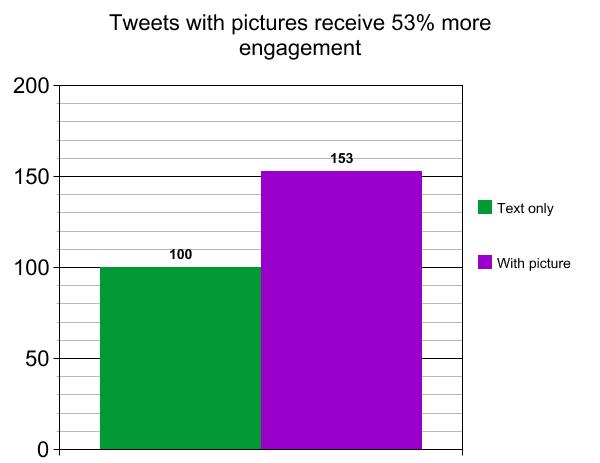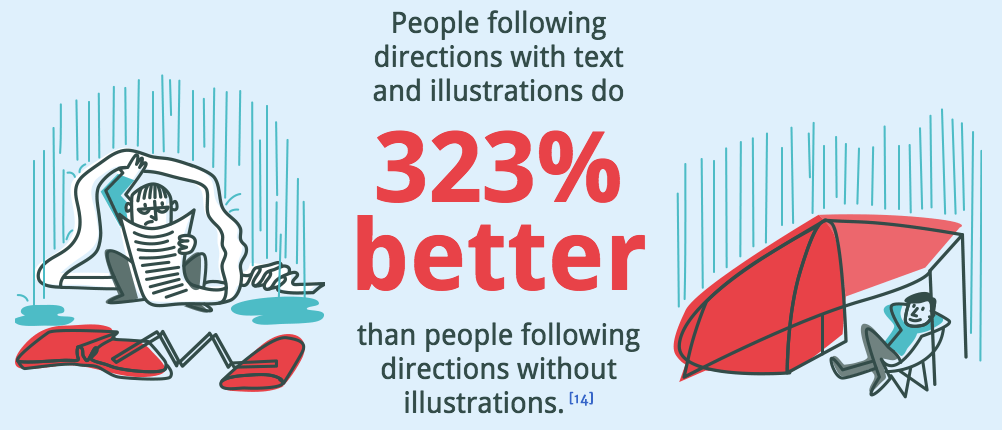In our increasingly visual world where the overflow of information makes individuals immune to content, good graphics and graphic design skills are pivotal to making your materials stand out.
In a post published by Huffington Post, content with visual context generates 53% more engagement than a text-based posts and that is a result of the Social media platforms, particularly Facebook and Twitter, redesigning their news feeds to place more emphasis on visuals.
Hubspot highlights this data as well in a recently published post referencing a Social Media Marketing Report (source).
1) 37% of marketers said visual marketing was the most important form of content for their business, second only to blogging (38%).
2) 74% of social media marketers use visual assets in their social media marketing, ahead of blogs (68%) and videos (60%).
3) When people hear information, they’re likely to remember only 10% of that information three days later. However, if a relevant image is paired with that same information, people retained 65% of the information three days later.
Understanding the importance of a good graphic, you may want to invest some time into learning graphic design.
Whether your intention is to use it for internal business purposes, your social media posts, to sell your products, or if you are considering doing this for a living – you don’t need to have a degree in graphic design to produce great quality work.
Here are a few tips for becoming a graphic designer
1. Learn to see
Before jumping into the technical angle of graphic design, like Photoshop, you need to learn the basics.Gain a great deal of understanding of the core skills, such as colors and typography, shape and spacing and how to use and combine all of them to convey a message.
Understanding the basics is important in getting a feel for how to work with these elements. Details like color can make areas of a design pop off the page or recede into the background. The use of texture can enhance the feel of a design. In print design texture can be the actual feel of paper or other materials. Imagery can also blend in with texture and is loaded with colors. Learning how to balance these is a delicate craft that will take some practice to apply well.
Steps you can take right now to help you get started:
• Drawing: get comfortable sketching with a pen, mastering shapes and placement
• Graphic design theory: learn color, typography, designing with grids and everything in between
• Writing: Wait, but this is graphic design! Yes, and it’s important to know that designs come with text, almost always. A great designer will fill their designs with text, thinking of the entire end user experience (as opposed to just placing a Lorem Ipsum)
2. Master the process
Every single illustration and graphic is a product of strategic combination of colors and patterns to convey a message or evoke emotions.
Analyzing the process behind a design will allow you to understand the steps required to produce a piece of work. Here’s how you can achieve that:
• You know more than you think you do
• When you identify holes in that knowledge, you’ll know what techniques or concepts you need to explore to narrow the gap
• There’s more than one way to achieve a desired result
3. Stick with a passion/niche
We all know how hard it is to work on something you don’t want to. It just plain sucks.
Picking a project that you aren’t passionate about will likely lead to frustration, as you’ll likely feel reluctant to devote the time and effort necessary to complete the project. And you would be remiss to ignore the fact that, at some point in your career, you’ll have to design something you may feel less than thrilled about but if you master the art of graphic design by working on something you are passionate about you can transfer those skills to almost any project.
4. Then stick with a specialty (source)
While becoming familiar with multiple types of graphic design, it’s impossible to become an expert in all and it’s best to stick with one specialty. There are many types of specialties you can choose from, for example:
• Logo design-take it even further, design business cards, websites, pamphlets
• Mobile app design:
• Web design
5. The tools!
Now that you have a deep understanding of the graphic design industry, you need something to design with! Tools like Photoshop and Illustrator are the most popular graphic design programs, the easiest to use and the most requested by employers and clients. So master them!
There are a ton of books, online tutorials and in-person classes to learn Illustrator and Photoshop. Choose the style that works best for you
How do you plan to incorporate your graphic design skills?



